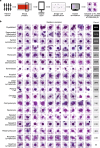A large expert-annotated single-cell peripheral blood dataset for hematological disease diagnostics
- PMID: 41219218
- PMCID: PMC12606192
- DOI: 10.1038/s41597-025-06223-x
A large expert-annotated single-cell peripheral blood dataset for hematological disease diagnostics
Abstract
Distinguishing cell types in a peripheral blood smear is critical for diagnosing blood diseases, such as leukemia subtypes. Artificial intelligence can assist in automating cell classification. For training robust machine learning algorithms, however, large and well-annotated single-cell datasets are pivotal. Here, we introduce a large, publicly available, annotated peripheral blood dataset comprising >40,000 single-cell images classified into 18 classes by cytomorphology experts from the Munich Leukemia Laboratory, the largest European laboratory for blood disease diagnostics. By making our dataset publicly available, we provide a valuable resource for medical and machine learning researchers and support the development of reliable and clinically relevant diagnostic tools for diagnosing hematological diseases.
© 2025. The Author(s).
Conflict of interest statement
Competing interests: The authors declare no competing interests.
Figures

References
-
- Fuchs, T. J. & Buhmann, J. M. Computational pathology: challenges and promises for tissue analysis. Comput. Med. Imaging Graph.35, 515–530 (2011). - PubMed
-
- Walter, W. et al. Artificial intelligence in hematological diagnostics: Game changer or gadget? Blood Rev.58, 101019 (2023). - PubMed
-
- Matek, C., Schwarz, S., Spiekermann, K. & Marr, C. Human-level recognition of blast cells in acute myeloid leukaemia with convolutional neural networks. Nat Mach Intell1, 538–544 (2019).
-
- Salehi, R. et al. Unsupervised Cross-Domain Feature Extraction for Single Blood Cell Image Classification. in Medical Image Computing and Computer Assisted Intervention – MICCAI 2022 739–748, 10.1007/978-3-031-16437-8_71 (Springer Nature Switzerland, Cham, 2022).
Publication types
MeSH terms
LinkOut - more resources
Full Text Sources
Medical

